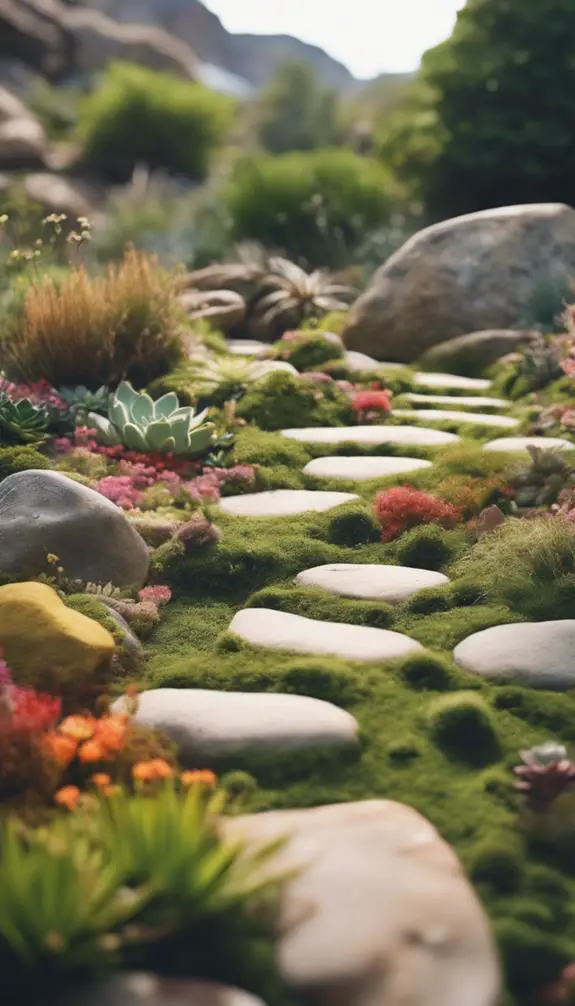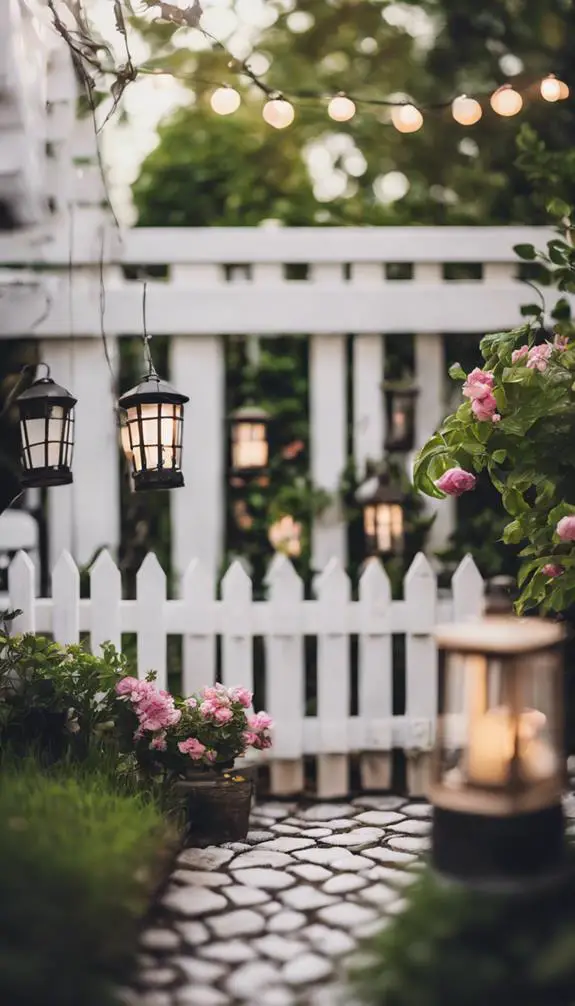As you envision your ideal outdoor space, you're likely considering a rock garden landscape that's both beautiful and low-maintenance. You're not alone – many homeowners are drawn to this style because it's perfect for busy people who want to enjoy their yard without constant upkeep. By combining the right rocks, plants, and design elements, you can create a tranquil oasis that's uniquely yours. But where do you start? With so many options for rocks, plants, and design styles, it can be overwhelming. That's why it's crucial to understand the basics before you begin building your rock garden – and that's exactly what we're about to explore.
Choosing the Right Rocks
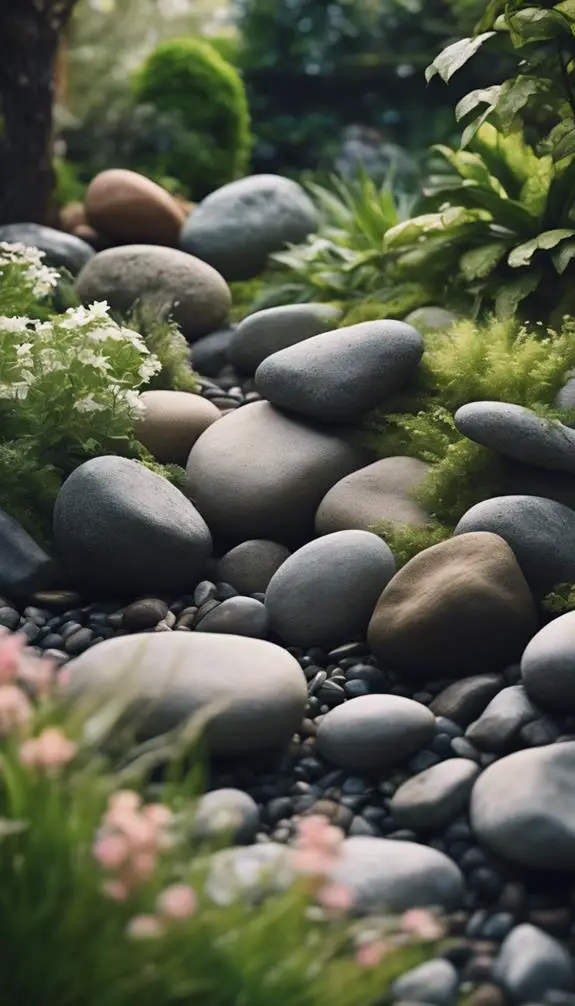
Selecting the ideal rocks for your rock garden is a pivotal step in creating a visually appealing and functional landscape.
You'll want to ponder rock color schemes that complement your existing outdoor décor and surroundings. Neutral tones like beige, gray, and white can provide a clean backdrop for vibrant plants, while bold colors like red, orange, and yellow can add energy to your design.
Rock texture variations are also essential, as they can add depth and visual interest. Mixing smooth, rounded rocks with rough, angular ones can create a dynamic, layered look.
Selecting Low-Maintenance Plants
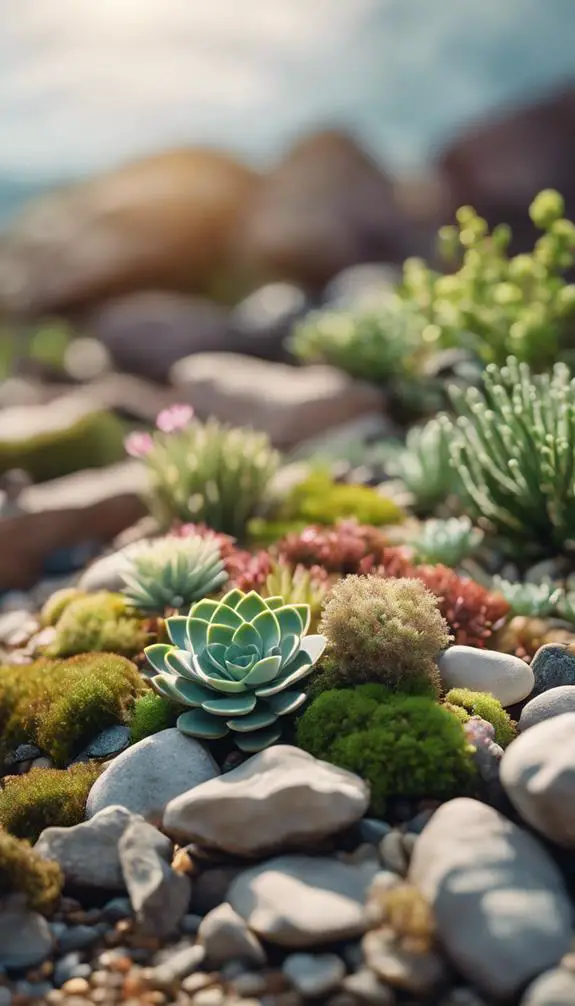
When designing your rock garden, you'll want to choose plants that not only thrive in well-draining soil but also require minimal upkeep.
You'll find that drought-tolerant options, such as sedum and yarrow, are perfect for hot, dry spots. By selecting succulents, cacti, and ground cover alternatives, you'll create a stunning, low-fuss landscape that complements your carefully chosen rocks.
Drought-Tolerant Plant Options
Three essential traits to look for in drought-tolerant plants are their ability to survive with minimal watering, thrive in well-draining soil, and require minimal pruning and maintenance.
When selecting plants for your rock garden, you'll want to focus on species that have adapted to dry conditions, such as those found in desert landscaping.
You can draw inspiration from Mediterranean flora, which has evolved to conserve water and thrive in hot, dry environments.
Look for plants with deep roots, waxy leaves, and gray or silver foliage, as these characteristics often indicate drought tolerance.
Succulent and Cacti Choices
You're likely familiar with the striking appearance of succulents and cacti, but did you know they're also some of the most low-maintenance plants you can add to your rock garden?
Succulent varieties like aloe, echeveria, and crassula are perfect for hot, dry spots, while cacti species like opuntia, echinocereus, and mammillaria thrive in full sun.
Both require infrequent watering, making them ideal for busy gardeners.
When selecting succulents and cacti, consider factors like climate, soil type, and desired texture.
Pair them with complementary plants, like creeping thyme or sedum, to create a visually appealing contrast.
With proper care, these plants will thrive, adding a touch of modern elegance to your rock garden.
Ground Cover Alternatives
Beyond the allure of succulents and cacti, low-maintenance ground covers can add depth and visual interest to your rock garden.
You can explore ground cover options that provide alternative textures to complement your chosen rocks. Consider Creeping Thyme, which forms a dense mat of tiny leaves and produces tiny flowers in summer.
Alternatively, Sedum or Sempervivum can add a delicate, spreading habit to your design.
If you prefer a more rustic look, Corsican Mint or Sweet Woodruff can provide a soft, grass-like texture.
Understanding Drainage and Erosion

As you design your rock garden, you'll need to manage water flow to prevent erosion and washaway areas.
You'll want to implement soil stabilization methods, like terracing or retaining walls, to keep your soil in place.
Water Flow Management
Water flow management is a crucial aspect of rock garden landscaping, where a subtle balance between drainage and erosion control must be maintained to prevent water from becoming a destructive force.
As you design your rock garden, you'll need to ponder how rainwater and stormwater will flow through the landscape.
You can implement rainwater harvesting systems to collect and store water for irrigation, reducing your water bill and minimizing stormwater runoff.
Effective stormwater management strategies, such as installing permeable pavers or creating rain gardens, will also help mitigate erosion and prevent water from accumulating in your garden.
Soil Stabilization Methods
By incorporating effective stormwater management strategies, you've taken the first step in creating a resilient rock garden.
Now, it's vital to focus on soil stabilization methods to prevent erosion and guarantee your garden's longevity. One effective approach is to use soil anchors, which secure the soil in place and prevent it from shifting or washing away.
Geotextile mats are another innovative solution, providing a porous layer that allows water to filter through while keeping soil particles in place. By combining these methods, you'll create a stable foundation for your rock garden, allowing you to enjoy its beauty for years to come.
Preventing Washaway Areas
In rock gardens, certain areas are more prone to washaway due to gravity, slope, and concentrated water flow.
You'll need to implement washaway prevention methods to guarantee your garden's integrity. Start by identifying high-risk areas, such as steep slopes, drainage channels, and zones with poor soil structure.
Next, apply erosion control strategies like terracing, mulching, or installing permeable pavers to slow down water flow and reduce runoff. You can also use geotextiles or landscape fabric to stabilize soil and prevent erosion.
Creating a Rock Garden Design
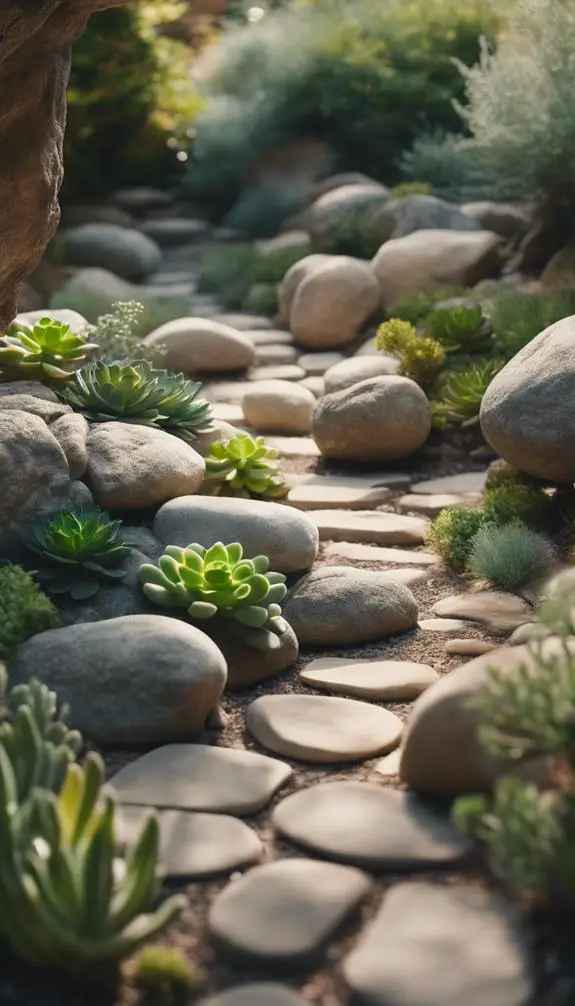
As you set out on creating a rock garden design, consider the overall aesthetic you want to achieve, taking into account the site's conditions, your personal style, and the type of plants you'll be using.
Rock placement is pivotal, as it sets the tone for your garden's theme. Will you opt for a natural, rustic look or a more modern, structured design?
Consider garden themes like alpine, desert, or woodland to guide your rock placement and plant selection. You can create visual interest by grouping rocks of varying sizes and textures or by incorporating focal points like large boulders or statues.
Building a Rock Garden Base
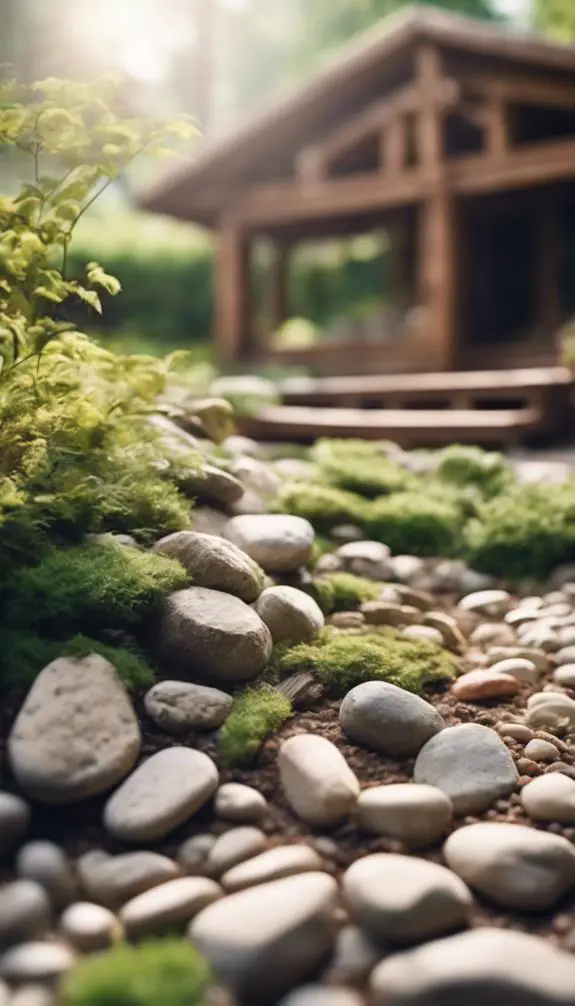
You'll start building your rock garden base by preparing the rock foundation, which involves clearing the area of any debris and leveling the ground to create a stable surface.
Next, you'll need to remove the existing soil, which can be done using methods like excavation, tilling, or stripping, depending on the soil type and depth.
Rock Foundation Preparation
Your rock garden's foundation is the backbone of your design, and a well-prepared base is essential for a stunning and long-lasting landscape.
You'll need to clear the site of debris, vegetation, and obstructions to create a clean slate for construction.
Rock excavation is a pivotal step, as it allows you to assess the natural terrain and identify potential drainage issues.
Use heavy machinery or manual tools to remove rocks, roots, and other obstacles, taking care not to damage the surrounding soil.
A thorough site clearing will guarantee a stable and even foundation, giving your rock garden a solid footing for years to come.
Soil Removal Methods
Three primary methods exist for removing soil when building a rock garden base: manual excavation, mechanical excavation, and a combination of both.
You'll need to assess the site's conditions and your resources to determine the best approach.
Manual excavation involves digging by hand, ideal for small areas or tight spaces.
Mechanical excavation employs heavy machinery, suitable for large-scale projects.
A combination of both methods might be necessary for sites with complex terrain.
Before starting, use soil testing tools to analyze the soil's composition and identify potential challenges.
Then, select the most effective soil excavation techniques to guarantee a solid foundation for your rock garden.
Adding Decorative Gravel Layers
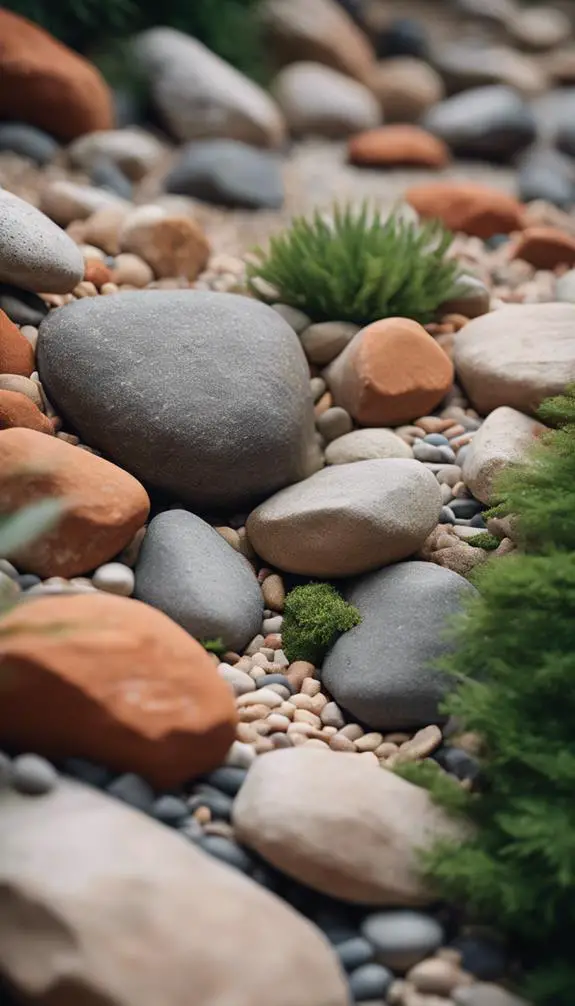
How can you effectively incorporate decorative gravel layers into your rock garden landscape without overwhelming the senses?
Start by selecting gravel with varying Gravel Textures, from fine to coarse, to create visual interest.
Consider Gravel Aesthetics, such as color, shape, and size, to complement your rock garden's overall theme.
Balance contrasting textures and hues to avoid visual overload.
Create a cohesive look by using a dominant gravel type and accenting with smaller, complementary layers.
Avoid over-graveling, as this can make your landscape appear cluttered.
Instead, strategically place gravel layers to enhance your rock garden's natural beauty, creating a harmonious blend of form and function.
Incorporating Water Features

Water's soothing presence can elevate your rock garden landscape, imbuing it with a sense of tranquility and dynamism.
As you incorporate water features, consider the visual appeal of Water Fountains, which can be designed to complement your rock garden's unique style.
For a more subtle approach, Pondless Falls can create a gentle, soothing sound without the need for a large body of water.
When selecting a water feature, think about the scale, sound, and visual impact you want to achieve.
You can also experiment with different materials, such as natural stone or metal, to create a unique and innovative design.
Using Lighting to Enhance Beauty

As the sun sets, your rock garden landscape transforms, and strategically placed lighting can further elevate its beauty, drawing attention to your carefully selected rocks, plants, and water features.
You can create a Moonlight Accent by positioning lights to mimic the soft glow of the moon, highlighting the textures and forms of your rocks and plants.
Alternatively, use Solar Highlight to emphasize specific features, such as a statement boulder or a flowing water feature.
Mixing Rocks With Mulch and Soil
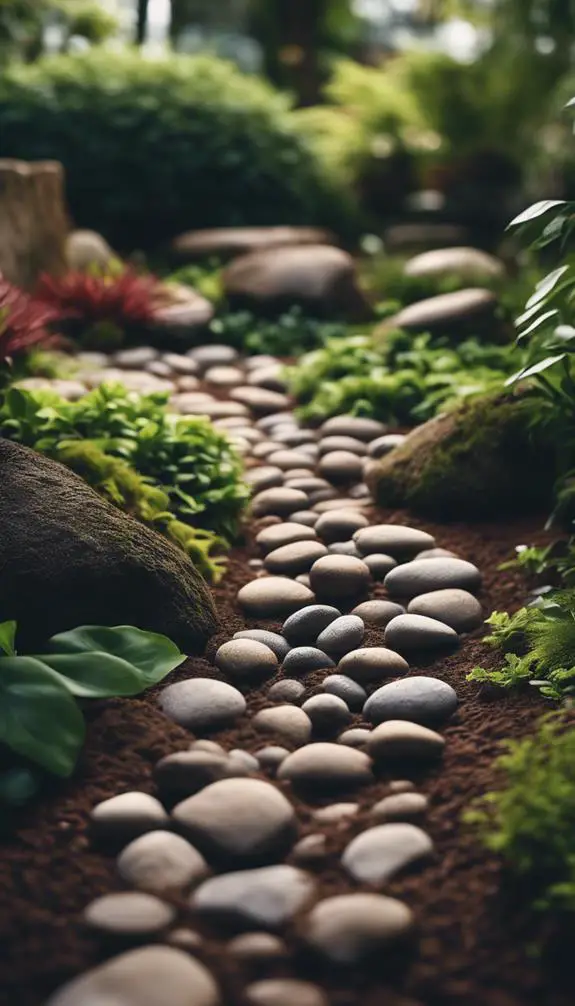
Your rock garden landscape's nighttime ambiance is now set, and it's time to focus on the underlying structure that brings it all together.
When mixing rocks with mulch and soil, crucially, you must strike the right balance. Aim for a rock proportion of 30-40% to allow for adequate drainage and aeration.
The mulch ratio should be around 20-30%, providing a layer of organic matter that retains moisture and suppresses weeds. The remaining 30-40% should consist of a well-draining soil mix that supports plant growth.
Rock Garden Maintenance Tips

By incorporating regular maintenance into your routine, you'll guarantee your rock garden remains a stunning oasis that continues to thrive.
To start, invest in a set of essential rock garden tools, including a rake, trowel, and pruners.
Perform seasonal tasks, like spring cleaning and winterizing, to keep your garden in top shape.
During spring, remove dead plant material and replenish mulch. In summer, water plants regularly and deadhead blooms.
Autumn brings leaf cleanup, while winter requires protecting plants from harsh weather.
Stay on top of debris removal and pruning to maintain your garden's structure and beauty.
Dealing With Weeds and Pests

Weeds and pests can quickly turn your serene rock garden into a chaotic mess, so it's vital to stay vigilant and take proactive measures to control them.
Installing weed barriers, such as landscape fabric or plastic sheeting, will prevent weeds from germinating in the first place.
For existing weeds, use a targeted herbicide or manually remove them, making sure to remove the entire root system to prevent regrowth.
Pest repellents, like copper tape or predator-attracting plants, can deter unwanted critters.
Regularly inspect your garden for signs of pests, and take action promptly to prevent infestations.
Rock Garden Design Inspiration

Rock garden design inspiration comes from a multitude of sources, including nature itself, architecture, and art.
You'll find ideas in the intricate patterns of rock formations, the curves of a Japanese garden, or the bold colors of a modern sculpture.
Consider the overall theme you want to create in your rock garden – do you want a serene, natural oasis or a vibrant, contemporary space?
Think about the style of your home, the surrounding landscape, and your personal taste to help guide your design.
You can also collect ideas from online resources, gardening books, and visits to public gardens.
Common Rock Garden Mistakes
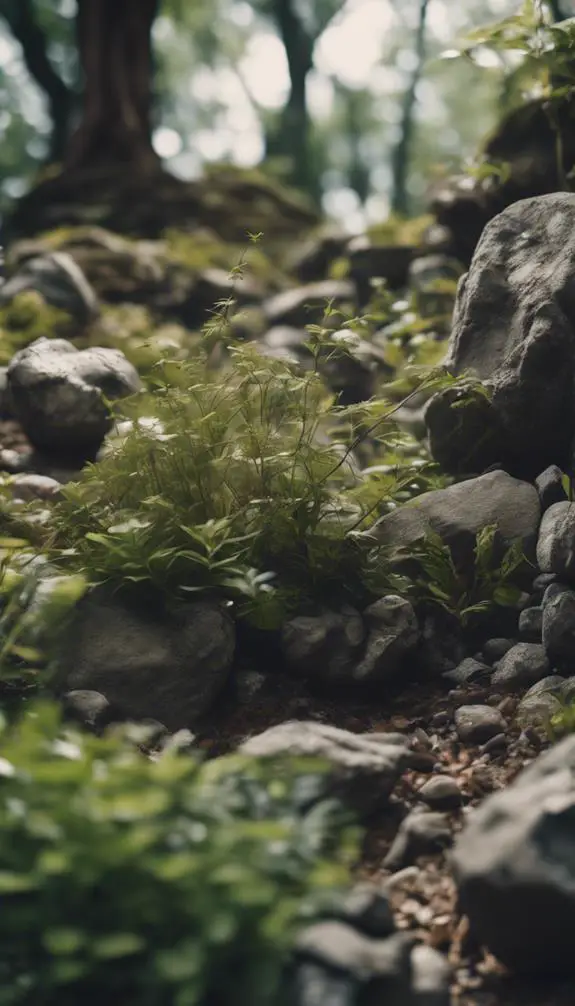
Your rock garden's potential is easily undermined by common mistakes that can turn your serene oasis into a chaotic mess.
One major error is poor rock placement, which can disrupt the natural flow of your garden. Avoid grouping rocks together or placing them in a straight line, as this creates an unnatural appearance.
Instead, strategically scatter rocks throughout your garden to create visual interest.
Another mistake is failing to define your garden goals. Before designing your rock garden, consider what you want to achieve. Do you want a peaceful retreat or a vibrant display of colors?
Clarify your goals to certify your rock garden meets your expectations. By avoiding these common mistakes, you can create a stunning rock garden that showcases your unique style.
Frequently Asked Questions
Can I Create a Rock Garden on a Slope or Hill?
You can create a stunning garden on a slope or hill by mastering slope stabilization techniques and incorporating thoughtful hillside design elements, ensuring a safe and beautiful space that defies gravity.
How Often Should I Water My Rock Garden Plants?
You'll need to establish a customized watering schedule, checking soil moisture daily, especially during hot spells, to guarantee your plants receive the right amount of hydration, avoiding overwatering that can lead to root rot and other issues.
Are Rock Gardens Suitable for Small Backyards or Spaces?
You can create an urban oasis in even the smallest spaces, as long as you're mindful of space constraints; by strategically selecting compact plants and optimizing layout, you'll craft a serene retreat that maximizes every inch.
Can I Use Rocks From My Own Yard or Property?
When sourcing rocks, you're likely wondering if you can excavate your own property. Yes, you can, but be sure to assess the quality, size, and type of rocks, ensuring they're suitable for your project, and consider consulting a professional for ideal rock sourcing and excavation.
Do Rock Gardens Attract Unwanted Insects or Animals?
You'll want to ponder that attractive gardens can lure unwanted visitors; to mitigate this, you'll need pest control methods and insect repellents, like neem oil or diatomaceous earth, to keep critters at bay and maintain a harmonious ecosystem.
Conclusion
You've successfully crafted a tranquil rock garden oasis. Now, it's time to sit back and enjoy the serenity you've created. Your thoughtful design and careful planning have resulted in a low-maintenance haven that will thrive for years to come. Remember to stay vigilant about weeds and pests, and don't hesitate to make adjustments as needed. With your rock garden, you've not only enhanced your outdoor space but also created a reflection of your personal style.


